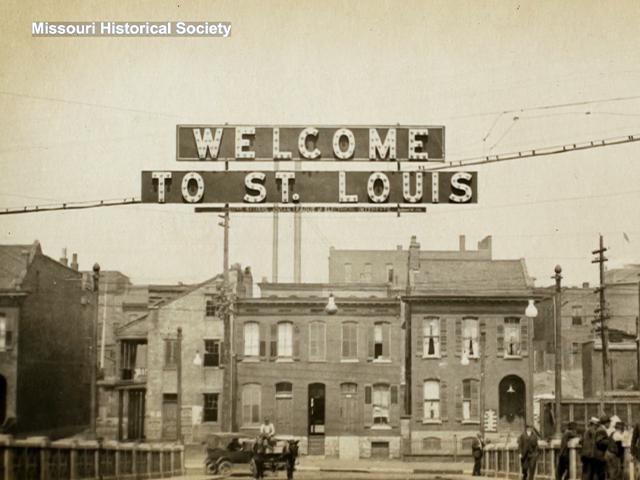'We Were Nearly Erased': City Wrestles with Painful Past of Urban Renewal
ST. LOUIS – A city steeped in a rich and vibrant but also messy history is on a path of addressing a painful chapter in its not-too-distant past.
Bordering the mighty Mississippi River, the former frontier post boasts 79 distinct neighborhoods. But a once-thriving Black neighborhood is missing from the current catalogue of communities.
Mill Creek Valley was first populated by European immigrants and became a predominantly Black community by the 1940s, when Black Americans left the South in search of work and educational opportunities during the Great Migration.
"We had our teachers, our doctors, our lawyers, grocery stores, businesspeople," recalled Vivian Gibson, who spent her early years in Mill Creek. "Your schoolteacher may have gone to your church."
Gibson chronicled her carefree childhood in a memoir called The Last Children of Mill Creek.
But the physical remnants of her memories have been vacated by vast, undeveloped lots and construction sites – eerily similar to the 1960s when the community was razed. By the time the clearance project was completed, thousands of buildings were bulldozed by what neighbors called the "headache ball."
"It made so much noise," recalled Lois Conley, who also fondly remembers growing up in Mill Creek before the community was gutted. "We would sit and watch this big machine on a crane toss this real big heavy ball and knock the house down."

Nathan Jackson runs a site about St. Louis history and gives walking tours of the city. He compares the stately homes of nearby neighborhoods like historic Soulard and Lafayette Square to Mill Creek before city leaders tore it down.
"It's pretty much a textbook example of exactly what they wanted to do and actually accomplished doing for obsolete neighborhoods," said Jackson of St. Louis History and Architecture.
He believes the city's Comprehensive Plan of 1947 destroyed St. Louis's "urban fabric" and separated once walkable contiguous communities in favor of wider roads and highways that spurred white flight and urban decay.
Zoning: A Complicated History
To Jackson, the person who bears the brunt of the blame is St. Louis's first full-time city planner: Harland Bartholomew.
"He doesn't get quite the same lens cast on him as Robert Moses," Jackson told CBN News, drawing a comparison to the well-known urban planner regarded as the man who rebuilt New York. "Harland Bartholomew, arguably, did equal amounts of damage, if not more, to the city of St. Louis."
Known as the "Dean of City Planning," Bartholomew, beginning in 1916, spent decades retooling St. Louis, advocating for slum clearance.
"Harland Bartholomew is extremely interesting because of the influence he had on almost every city in the United States," said Sarah Williams, who directs MIT's Center for Advanced Urbanism.
Experts point to his use of zoning laws targeting poor and predominantly Black areas like Mill Creek.
"Imagine living in that community and then it being transformed so that you have liquor stores in your community or brothels in your community. And that meant disinvestment," explained Williams, who, unlike early urban planners and municipal leaders, trains students how to use data in ethical, responsible ways and to uplift often marginalized community voices.
Historically, when a neighborhood was targeted for slum clearance, it was first designated either as "blighted" or "obsolete," as was the case for Mill Creek.
"That was important to be able to tear it down," Gibson told CBN News. "Voters had to vote on a bond issue. And it's a lot easier to tear down a slum than it is to tear down a community of 20,000 working people."
Path of Destruction, Decades of Harm
The decision erased 5,000 housing structures, 800 businesses, and 40 churches and forced 20,000 people to search for new homes. Many had few options, however, due to racially restrictive housing covenants limiting where Blacks could live.
"Finding a place to relocate with eight children that they, one, could afford and that they felt was going to be safe and nurturing for us was quite a challenge," recalled Conley, referring to her parents' search for a new home in the 1960s.
Using data focused on Black movement and growth, Bartholomew repeated this pattern in designs for more than 500 cities and counties – from Washington, D.C. to Kansas City to Pittsburgh to Vancouver, Canada.
In his book Richmond's Unhealed History, author Ben Campbell argues that the former Confederate capital can be redeemed and fulfill its promise through prayer and hard work by honest brokers. Part of that work includes addressing the devastating effects of racially-motivated practices that supported segregation, inlcuding zoning laws popularized by Bartholomew.
"He called for large urban expressways going through the downtown areas. And, in this case, he built one 18 blocks through the Black community," Campbell told CBN News.
The Episcopal priest and civil rights activist took our crew to the historic Jackson Ward neighborhood overlooking the confluence of Interstates 64 and 95 in a stretch of highway called the Richmond-Petersburg Turnpike.
Immediately to the south of the turnpike, a lone two-story, red brick church building sits nearby, oddly out of place. The property is perched a few feet away from the steady, noisy hum of traffic produced by the mix of cars, trucks, and semis whizzing by at high speeds.
In the 1950s, the historic Sixth Mount Zion Baptist Church, a prominent anchor in a community once called the "Harlem of the South," was slated for demolition. Campbell credits its survival to one attentive city employee.
"The Black woman who was an elevator operator in City Hall, and a member of Sixth Mount Zion [Baptist] Church, as she ran that elevator up and down every day and listened to city planners talk about what they were going to do with the expressway, she informed the congregation," he explained. "And the Black community's only victory in this entire project was to get this road moved 10 feet so that Sixth Mount Zion Church would not be torn down."
Season of Change
While recent census information shows thousands of Black residents leaving places like St. Louis to seek better opportunities elsewhere, some of the surviving children of Mill Creek – now seasoned seniors – told CBN News they're staying to safeguard their stories.
"If everybody leaves, who then does the work? Where then is the hope that change can occur?" asked Conley, who started the Griot Museum to preserve the city's Black history.
"So, I'm here for the long haul, both in St. Louis and at the Griot," she added.
One of the newest additions to the city's downtown landscape is CityPark, the soccer stadium for St. Louis's new Major League Soccer team. The 22,000 seat venue is located in what was Mill Creek.
Before St. Louis City SC played its first MLS match at home in March 2023, team owner, Carolyn Kindle, invited former residents to the new stadium for a dedication of a memorial to the Mill Creek Valley. The unveiling of an outdoor monument called Pillars of the Valley was timed to commemorate the start of the neighborhood demolition project 64 years earlier.
"Every place has a history, and this is part of ours," Kindle told the crowd in February.
"With our stadium district overlapping the footprint of Mill Creek Valley, we knew it was important to acknowledge the hard truths from St. Louis's past," she said. "We want visitors to learn, honor, and remember the history and stories of who was here before us."
Surviving residents returned to their old stomping grounds as guests on familiar terrain at the bittersweet homecoming. Still, the overwhelming sentiment was gratitude for acknowledging the painful past, starting important conversations about how to avoid similar mistakes in the future, and not allowing their stories – their history – to be erased.
"I feel like we snatched it back from disappearing completely," Gibson told CBN News.
***Please sign up for CBN Newsletters and download the CBN News app to ensure you keep receiving the latest news.***




